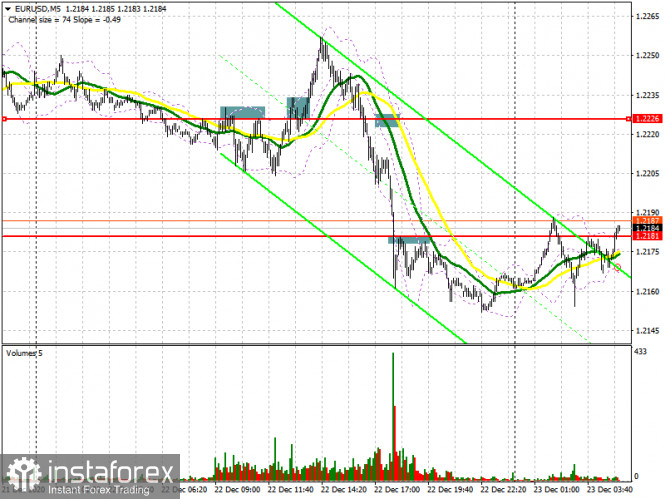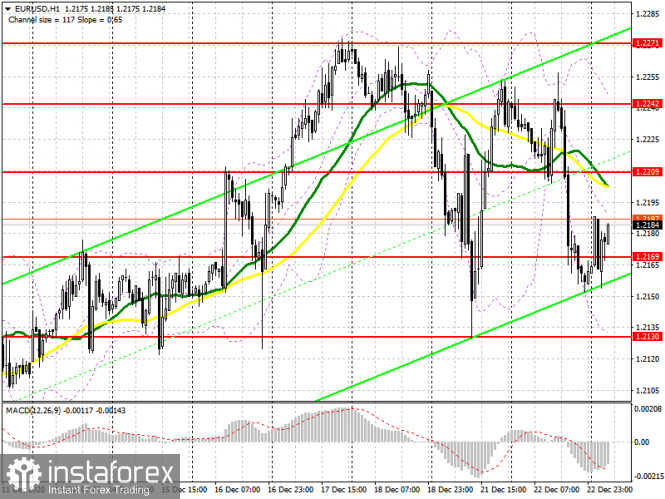
To open long positions on EUR/USD, you need:
Quite a lot of deals for entering the market appeared yesterday. Let's deal with them. In the first half of the day, you can see how the bears went below the 1.2226 level and settled below this range, testing it from the bottom up several times. This led to creating a clear signal to sell the euro. Moving from the 1.2226 level was around 20 points, afterwards buyers took control of this level, and tested it from top to bottom, which led to a buy signal. The upward movement was around 30 points. Unfortunately, I did not enter short positions during the US session after surpassing 1.2226, since this level was not tested similar to the morning sale. However, by the end of the day, there was a good signal to open short positions after settling below 1.2181 and this level was also tested from the bottom up. I selected all entry points on the chart.

The picture has slightly changed at the moment. Buyers are now focused on protecting support at 1.2169. Forming a false breakout there in the first half of the day will lead to creating a signal to open long positions in the euro. However, given the absence of important fundamental statistics, and since the report on the German import price index is unlikely to shake the market, buyers are probably not in a hurry to take an active part. If bulls are not active and EUR/USD returns to the area under the support of 1.2169, I recommend postponing long positions until the week's low has been updated in the 1.2130 area. It is also possible to buy the euro immediately on a rebound from a new local low in the 1.2083 area, counting on a correction of 20-25 points within the day. It will be possible to say that buyers of the euro managed to regain control of the market only when the pair manages to settle above the resistance of 1.2209, where the moving averages are, playing on the side of sellers. Testing 1.2209 from top to bottom creates an additional signal to buy the euro with the main goal of returning resistance at 1.2242, where I recommend taking profits.
To open short positions on EUR/USD, you need:
Sellers of the euro hope to regain control over the 1.2169 level. Getting the pair to settle below this range and testing it from the other side will increase the pressure on the pair, which creates a good entry point for short positions. In this case, the main target will be this week's low at 1.2130. You can expect a breakthrough in this area if we receive news of infections with a new strain of coronavirus in Germany or France. In this case, it is possible to fall further towards the 1.2083 area, and the main target at the end of the week will be the 1.2042 area, where I recommend taking profits. If the bulls manage to defend support at 1.2169, you can expect the pair to slightly advance to a 1.2209 high. However, I recommend opening short positions from there only when a false breakout has been formed. It is best to count on selling on a rebound only after levels 1.2242 and 1.2271 have been tested, counting on a downward correction of 20-25 points within the day.

The Commitment of Traders (COT) report for December 15 showed an increase in short positions and a reduction in long ones. Although buyers of risky assets believe that the bull market will proceed, especially amid expectations of vaccinations in the eurozone, which will begin from December 25 to 27, however, the rush to buy at current highs has obviously decreased. Thus, long non-commercial positions fell from 222,521 to 218,710, while short non-commercial positions increased from 66,092 to 76,877. The total non-commercial net position fell from 156,429 to 141,833 a week earlier. The growth of the delta, which was observed for three consecutive weeks, has stopped, so one can hardly count on the euro's rapid growth at the end of this year. There will be no further major recovery until European leaders negotiate a new trade agreement with Britain.
Indicator signals:
Moving averages
Trading is carried out just below 30 and 50 moving averages, which indicates the euro sellers' attempt to bring back the downward trend.
Note: The period and prices of moving averages are considered by the author on the H1 hourly chart and differs from the general definition of the classic daily moving averages on the D1 daily chart.
Bollinger Bands
A breakout of the average border of the indicator in the 1.2189 area will lead to a new upward movement for the euro. The euro's decline will be limited by the lower level of the indicator around 1.2130.
Description of indicators
Moving average (moving average, determines the current trend by smoothing out volatility and noise). Period 50. It is marked in yellow on the chart.Moving average (moving average, determines the current trend by smoothing out volatility and noise). Period 30. It is marked in green on the chart.MACD indicator (Moving Average Convergence/Divergence — convergence/divergence of moving averages) Quick EMA period 12. Slow EMA period to 26. SMA period 9Bollinger Bands (Bollinger Bands). Period 20Non-commercial speculative traders, such as individual traders, hedge funds, and large institutions that use the futures market for speculative purposes and meet certain requirements.Long non-commercial positions represent the total long open position of non-commercial traders.Short non-commercial positions represent the total short open position of non-commercial traders.Total non-commercial net position is the difference between short and long positions of non-commercial traders.